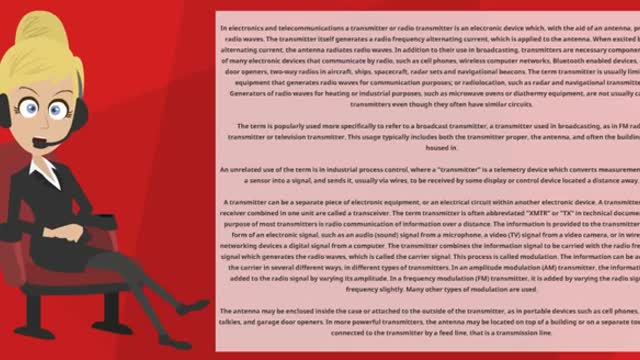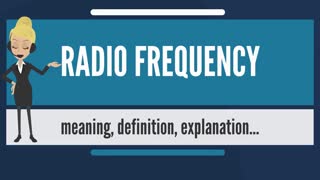Premium Only Content

What is a TRANSMITTER? TRANSMITTER meaning, definition & explanation for Amateurs
In this video, viewers will learn What a TRANSMITTER is, meaning, pronunciation, definition and explanation.
At the end of this video, viewers are expected to have a deeper knowledge about Transmitter.
Source: Wikipedia.org article, adapted under https://creativecommons.org/licenses/... license.
In electronics and telecommunications a transmitter or radio transmitter is an electronic device which, with the aid of an antenna, produces radio waves. The transmitter itself generates a radio frequency alternating current, which is applied to the antenna. When excited by this alternating current, the antenna radiates radio waves. In addition to their use in broadcasting, transmitters are necessary component parts of many electronic devices that communicate by radio, such as cell phones, wireless computer networks, Bluetooth enabled devices, garage door openers, two-way radios in aircraft, ships, spacecraft, radar sets and navigational beacons. The term transmitter is usually limited to equipment that generates radio waves for communication purposes; or radiolocation, such as radar and navigational transmitters. Generators of radio waves for heating or industrial purposes, such as microwave ovens or diathermy equipment, are not usually called transmitters even though they often have similar circuits.
The term is popularly used more specifically to refer to a broadcast transmitter, a transmitter used in broadcasting, as in FM radio transmitter or television transmitter. This usage typically includes both the transmitter proper, the antenna, and often the building it is housed in.
An unrelated use of the term is in industrial process control, where a "transmitter" is a telemetry device which converts measurements from a sensor into a signal, and sends it, usually via wires, to be received by some display or control device located a distance away.
A transmitter can be a separate piece of electronic equipment, or an electrical circuit within another electronic device. A transmitter and a receiver combined in one unit are called a transceiver. The term transmitter is often abbreviated "XMTR" or "TX" in technical documents. The purpose of most transmitters is radio communication of information over a distance. The information is provided to the transmitter in the form of an electronic signal, such as an audio (sound) signal from a microphone, a video (TV) signal from a video camera, or in wireless networking devices a digital signal from a computer. The transmitter combines the information signal to be carried with the radio frequency signal which generates the radio waves, which is called the carrier signal. This process is called modulation. The information can be added to the carrier in several different ways, in different types of transmitters. In an amplitude modulation (AM) transmitter, the information is added to the radio signal by varying its amplitude. In a frequency modulation (FM) transmitter, it is added by varying the radio signal's frequency slightly. Many other types of modulation are used.
The antenna may be enclosed inside the case or attached to the outside of the transmitter, as in portable devices such as cell phones, walkie-talkies, and garage door openers. In more powerful transmitters, the antenna may be located on top of a building or on a separate tower, and connected to the transmitter by a feed line, that is a transmission line.
Many thanks to "The Audiopedia".
License
Creative Commons Attribution license (reuse allowed)
-
 2:28
2:28
Amateur Radio and All about Ham Communication
4 years ago $0.02 earnedWhat is FREQUENCY MODULATION? FREQUENCY MODULATION meaning and Use for Amateurs
437 -
 4:18
4:18
Interesting misc, everything IMO
4 years ago $0.36 earnedWhat is MEL'S HOLE? What does MEL'S HOLE mean? MEL'S HOLE meaning, definition & explanation
392 -
 8:29
8:29
Amateur Radio and All about Ham Communication
4 years ago $0.08 earnedWhat is RADIO FREQUENCY? RADIO FREQUENCY, Its Meaning and Explanation
1.88K2 -
 12:38
12:38
Liz Watt | Life. Reality. Spirituality. Self
4 years ago $0.05 earnedWhat Is Spirituality And Awakening? A Simple Definition And Meaning
9511 -
 54:54
54:54
iCkEdMeL
3 hours ago $52.53 earned🔴 BREAKING: Gunman Opens Fire at Tim Pool’s Home
78.7K45 -
 3:27:43
3:27:43
GamingWithHemp
4 hours agoPlaying Metroid Prime 4 episode 1 A new beginning
5.1K -
 2:30:55
2:30:55
I_Came_With_Fire_Podcast
13 hours agoPuerto Rico, Corruption, Ther Sterilization of Women, and the Bankers Behind it All
26K18 -
![Mr & Mrs X - [DS] Pushing Division, Traitors Will Be Exposed, Hold The Line - EP 18](https://1a-1791.com/video/fwe2/96/s8/1/w/U/W/F/wUWFz.0kob-small-Mr-and-Mrs-X-DS-Pushing-Div.jpg) 54:40
54:40
X22 Report
7 hours agoMr & Mrs X - [DS] Pushing Division, Traitors Will Be Exposed, Hold The Line - EP 18
113K34 -
 3:14:03
3:14:03
ttvglamourx
5 hours ago $3.13 earnedHAPPY SATURDAY !DISCORD
34.4K3 -
 18:53
18:53
Wrestling Flashback
23 days ago $10.14 earned10 WWE Wrestlers Who Ruined Their Bodies Wrestling Too Long
40.7K4